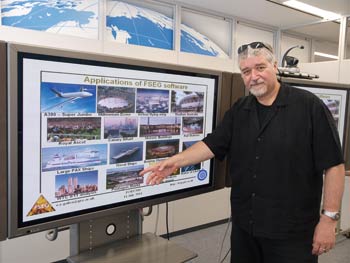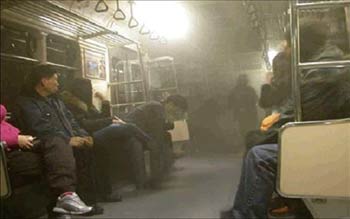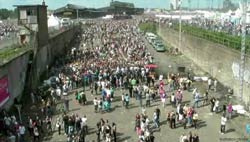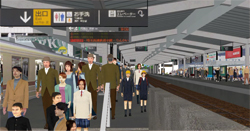----Why did you start to develop EXODUS?
| Prof. Galea |
|
Currently, I am in charge of the director of Fire safety engineering group,
University of Greenwich, UK. There are 32 staffs in this laboratory. We
have developed the evacuation simulation software "EXODUS" and
the fire simulation software "SMARTFIRE".
I majored two fields in the university. I studied the modeling of the stars
for doctor's degree. This is the study of the representation of the stars
considering the rotation of the stars with the computational fluid dynamics(CFD)
and the magnetofluid dynamics.
After that, I worked for the steel company as an engineer who analyzes
the magnetofluid CFD. I performed the simulation of the process of "continuous
cast" where the steel melted from the steel furnace is continuously
processed to slab.
In addition, I researched on the generation process of the sun spot using
magnetofluid dynamics analysis in University of St Andrews.
When I was transferred to the University of Greenwich, the accident occurred
in 1985. The fire occurred while Boeing 737 air plane was on the airstrip
in the Manchester airport, and 55 people lost their lives. The airplane
is designed for the passengers, crews to evacuate in 90 seconds. Despite
this, I was wondering if 55 people died. This accident made me start the
development of the software which became the prototype of EXODUS. |
 |
| Prof. Galea explaining the use of EXODUS(at FORUM8 Tokyo head office) |
----Why couldn't they all evacuate in 90 seconds?
| Prof. Galea |
|
In the accident of the Boeing 737, one of two who are sitting next to each
other was alive, and another was not. Hence, I surveyed the accident by
asking details of the situation to the remaining survivors. An unbelievable
thing was discovered.
The survivor could not move from his seat as the person who was sitting
next to him did not move. As a result, he crossed over the seat and went
to the emergency exit. Many young people did the same thing.
I collected the videos of "90 seconds test" from the airplane
manufactures such as Boeing and Douglas Aircraft Company, and analyzed
how people escaped one by one.
In the result, it was found that many people hesitated to jump into the
escape chute, and the escape time was extended. This elapsed time changed
depending on the size of exit whether it was for two people or one, and
how to use it whether people could go down directly from the exit to the
land or they need to go up to the main wing first. Hence, it was found
the elapsed time and the number of people who could escape was represented
with "normal distribution".
When a fire occurrs, one cannot simply calculate the number of people that
can escape from the emergency exit per minute by calculating the area and
width of it.
The software which considers the human psychology and behavior in the emergency
condition was completed as "Air EXODUS" in 1992. The accuracy
of analysis matched to the actual results. Next, I focused on the application
this functions to the building and ship. Unlike airplane, there are multiple
floors and people needs to select various routes and steps for the evacuation
so that the evacuation route becomes more complex. In addition, in case
of the ship, the evacuation speed changes when the ship is tilted to one
side. Therefore, it required a more complex model as compared to the airplane.
Hence, "building EXODUS" for the buildings and "maritime
EXODUS" for the ships were developed.
On the other hand, "SMARTFIRE" which allows the simulation of
the movement of the fire smoke in the building and ship the fire with the
computational fire dynamics was developed.
Currently, EXODUS has been used in the design of various buildings and
ships. For example, the stadium of Beijing Olympic, the statue of liberty
in NewYork, and the airbus A380.
It has been used in 35 countries until now. Most of them were the design
of buildings and ships to which the performance design was applied not
the simple buildings and facilities which can be designed with just the
design criteria. |
 |
|
 |
|
 |
| Site of the fire occurred in the subway in Korea, 2003. People who escaped
immediately made up only 7%, and most people did not move. |
|
The movement of the crowd of people in the open space (Left) and the analysis
result of EXODUS (Right) were very similar quantitatively. (Documents provided
by : Prof.Edwin R Galea) |
----I see. It cannot calculate the people's flow in the emergency condition
with the simple theory just like the fluid, can we?
| Prof. Galea |
|
No, however, first I have to think the underlying cause that people do
not try to move in the time they should escape. We call it "Response
time". Generally, the evacuation time is considered based on the assumption
that people tends to move at once the accident occurs, in other words,
the response time is zero. However, the actual behavior is largely different.
I have done the hearing investigation of more than 1000 people who are
the survivors of the fire and other accidents. The data of behavior was
registered in "ASK database".
For example, I surveyed 300 of 9/11 survivors for three years, and found
some people did nothing 15 minutes after the outbreak of the accident.
The culture difference largely affects the evacuation behavior such as
response time, hence the organization "Bureau of Security and Culture"
performed the evacuation experiments in the university library in four
countries, Czech, Poland, Turkey, and UK to study it. 50 hidden video cameras
were arranged in each library on the day before experiment, very late at
night, and it sounded a fire alarm suddenly. We recorded and analyzed how
the student acted in the emergency situation.
It was expected that the students in UK started to escape first; however,
it was the students in Turkey. The reason is not clear yet, but it may
be because they have experienced the big earthquake in the past. The second
was Poland, the 3rd was UK, and the fourth was Czech.
According to the investigation, it was found that the students who have
never heard the evacuation signal were 70% in UK, and 90% in Czech. |
----The culture and national character affect the behavior of people in
emergency situation.
| Prof. Imamura |
|
Yes. For example, one of the things which affect the movement of the crowd
in the urban area is the escalator. It is very interesting that the percentage
of people who are walking and stopping on the escalator is depending on
the country. According to the investigation in Barcelona in Spain, Shanghai
in China, London in UK, 90% of people are stopping in Shanghai as well
as many people are walking in London. Many people tend to walk in Barcelona,
but not so many as in London.
As for the fire evacuation on the high-rise building, the number of people
using the elevator affects the result of evacuation simulation. The points
are the waiting time and the level they are staying.
To survey it, I investigated via Internet globally. It was assumed that
the safety of elevator was secured in the fire condition.
In the result, one of three replied that he uses the elevator. Looking
at it country by country, 1/2 in US, 1/4 in China, 1/3 in UK, and less
than 1/3 in Germany replied yes. The cultural differences are reflected
here as well.
Looking at it floor by floor, generally, people at higher level tends to
use the elevator. However, it was found that 20% of people never uses elevator
even they are in more than 30th floor.
The number of people using the elevator decreases based on the waiting
time. Many people selected the stairs after 10 minutes, and 15 minutes
are the maximum for waiting the elevator.
EXODUS covers the behavior pattern based on the culture and nationality
as data. |
 |
Passenger flow simulation in Nakameguro station.
The flow of crowd is visualized by linking EXODUS with UC-win/Road. |
----EXODUS is not the software for simulating the objects with the pure
physical law such as fluid dynamics and structural dynamics, but the software
for analyzing with the consideration of the human psychology and behavior
based on the different culture and nationality, isn't it?
| Prof. Galea |
|
That's right. It considers the dominant arm and the living habit as well.
For example, when the evacuation route is divided into left and right,
there is the specific rule which they will choose. According to the investigation
of the people in 36 countries, the 64% of righty choose the right path.
The percentage changed depending on the traffic rule. In the country of
right-hand traffic such as US and China, 75% of people chose the right
path, and in the country of left-hand traffic such as Japan and UK, 60%
of people chose the right path.
According to a broadcasting of this story by BBC, UK, I received the mail
from an experienced member of the rescue team in the forest, NewZealand.
They could find the person who got lost in a forest by choosing the right
path in 70-80% of cases. He was wondering it, and understood the reason
because of my story.
In the new version of EXODUS which will be released in future, the function
of "Way Finding" will be mounted. Generally, the evacuation is
performed based on the information sign, the minimum distance, and the
information from other people.
When the way finding is turned OFF, the crowd tries to evacuate through
the minimum distance path. However, if it is turned ON, some people are
evacuating through different path other than the minimum distance path. |
----In this Great East Japan Earthquake, the big damage was caused by Tsunami.
To reduce the damage of Tsunami, can we use EXODUS ?
| Prof. Galea |
|
I am not a professional of Tsunami, but I think EXODUS can be used for
the evacuation from Tsunami. In this case, we need to develop the function
for dealing with the large-scaled size of data such as several kilometers
square.
We can use EXODUS for the planning of the evacuating simulation and the
evacuating strategy of Tsunami by setting the position of evacuation center,
evacuation path, how to alarm, and response time.
It is required to consider the combination with not only the people's behavior
but the movement of vehicles at that time. For example, it can considered
that the simulation method of the movement of people and vehicle by linking
EXODUS with UC-win/Road.
As for the response time, I don't know the Tsunami case, but BESECU has
the data of the evacuation of flood in Europe. |
----Prof. Galea, you have performed the hearing investigation to the survivors,
is there any specific skill for it..?
| Prof. Galea |
|
When the large-scaled disaster occurred, the social network services(SNS)
such as Twitter, Facebook, and Youtube and the portable phone function
as the multi directional communication method between the disaster area
and government, and the exchange of the information such as GIS can be
performed by the movies and photos. People are familiar with this kind
of communication tools so that they can be easily used in the disaster
situation.
However, when the disaster occurs, the most important thing is escaping
to the safe place. The transmission of information is the second step.
In 9/11, many people in the world trade center issued "SOS" first
by the portable phone. This is the wrong order. In this case, they needed
to escape from the building first. |
----Is there any method for saving the life by applying EXODUS to the existing
buildings and facilities ?
| Prof. Galea |
|
For the people who need to provide the order in the large disaster such
as the people in government, it is very important to have the training
to make a judgment in the emergency situation. As it is a little difficult
for them to have an actual experience, they need to practice how to provide
the order to the evacuee, and the rescue team based on the ever-changing
condition using UC-win/Road and EXODUS.
For example, they can practice whether they send the firefighters to the
25th floor of the building where the fire occurs. The high-accuracy model
and the high quality representation method allow the very effective training.
In two years ago, I simulated the above mentioned fire accident of B373
in the Manchester airport again using SMARTFIRE and EXODUS. The result
showed from 50 to 61 people died, and 57 people died in the average of
some experiments. Nowadays, we can make a prediction the result with a
high degree of accuracy by the position of the fire origin and emergency
exit.
As of the range of EXODUS in future, it will be important to verify the
accident actually happened, not only the design of the facilities. In addition,
we can imagine the use for the countermeasure for the terrorism using the
chemical weapon. For example, it can study the countermeasure for the terrorist
assuming the damage when the poisonous gas is pumped from the air-conditioning
system in the subway station and office building. |
----Thank you very much for today.
(Interviewed/written by : Ryuta Ieiri) |





